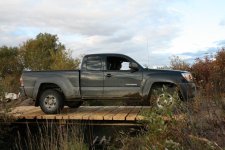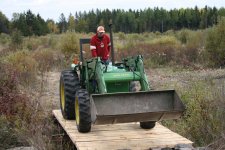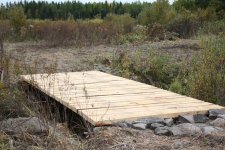Couple of suggestions.
1. Trailer is quickest, easiest, and pretty cheap if you are patient and wait on the right deal. Do some serious CL shopping before you rule this out.
2. Look for steal beams. Some 12-15' steel beams in the 10"-12" depth range I usually see on CL all the time for next to nothing. Worst case scenerio you have to buy new beams. Around here that is ~50 cents a pound. Even something as small as a W8x21 beam has the ability to carry ~4500# point load right at mid span and still have a 5:1 safety factor. A 40' stick would be ~820# and with a few cut fees to whatever size you need would probably run under $500. Then all you need is decking. Probably a good bit cheaper than you $1000+ budget.
3: Contact your local electric companies and inquire about used poles. I did a bridge spanning only about 4' this way (but drove 18k backkhoe over it). Basically use the electric poles the same way you are wanting to laminate the 2x8's. Only alternate every other one, cause the poles are tapered, So have big end on near side, then next one have it on the far side, then back to near side, etc etc. Think like making a raft.
Electric poles are usually 8-10" diameters, and treated really well. The electric companies usually give away used and broken poles. Most times still in pretty good shape. But sometimes not, avoid the ones taken out of service for rot. But lots are just where they have moved a line for one reason or another, (they dont re-use poles no matter the shape), or some are broken from stormes or accidents. The broken ones are fine cause poles are 40' or so long, lots of times you can still get two good 15' lengths.
After you have all the poles laid out spanning the creek, lay down decking with some polebarn spikes. Decking over it ties everything together and keeps the tires from just "displacing" and rolling the poles out from underneath you.
My absolute last resort would be the all wood beam as you describe or a all wood bridge with wood beams and wood decking. Lots better (and cheaper) solutions out there. I dont like to mess around with heavy things crossing bridges, do it right.




